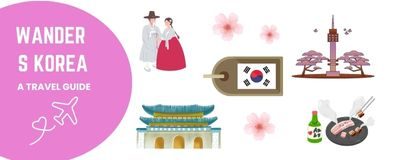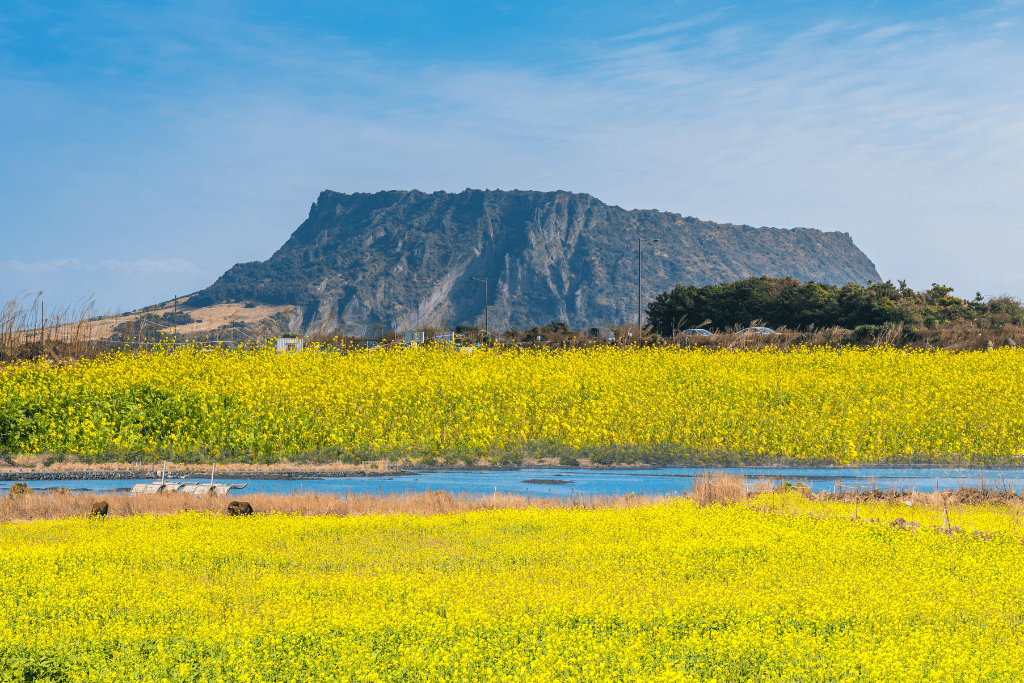
Golden fields stretching toward ancient volcanoes. Welcome to Jeju Island, where the landscapes feel straight out of a storybook.
Whether you’re chasing waterfalls, climbing craters, or relaxing along the coast, Jeju has a little magic tucked around every corner.
If Jeju Island isn’t on your South Korea itinerary yet, it absolutely should be.
Nicknamed “Korea’s Hawaii,” Jeju is packed with natural beauty and unexpected charm. Think lava tubes, coastal cliffs, and the quirkiest lip balm you’ll ever find (yes, I’m talking Dolhareubang-shaped).
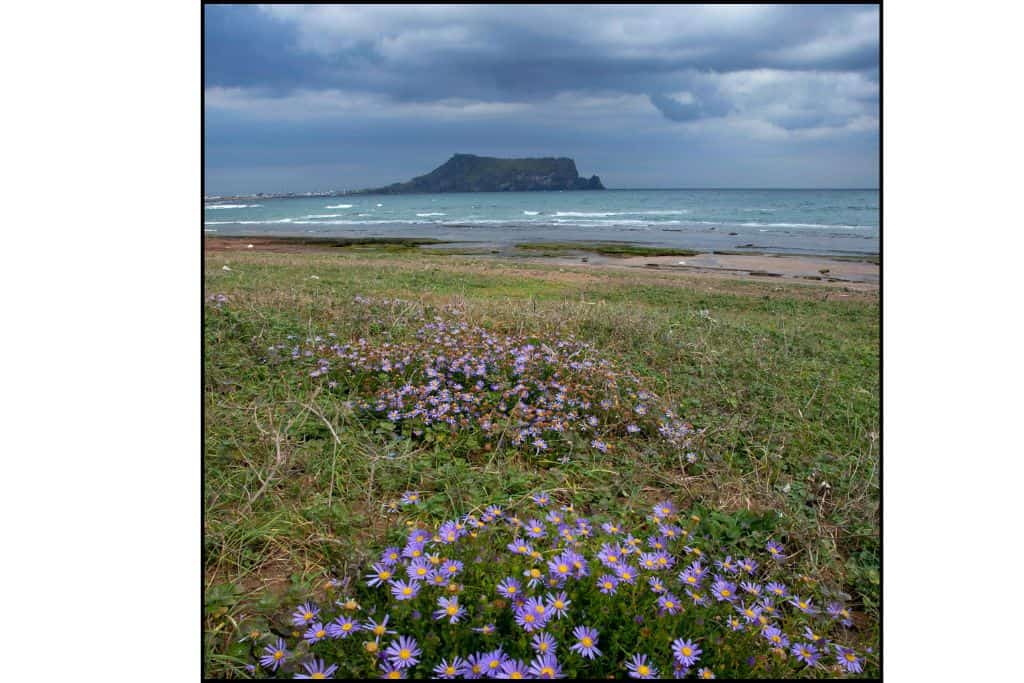
To make the most of my time, I opted for a guided tour that hit some of Jeju’s major highlights.
No car rentals, no stressing over bus schedules, just pure sightseeing bliss.
In this guide, I’ll cover how to get to Jeju, where to stay (including where I stayed), what I explored, and what’s still on my Jeju wish list.
If you’re dreaming about your first visit or already planning your Jeju comeback, you’ll find plenty of inspiration (and maybe a few surprises) here.
Best Places to Visit on Jeju Island (First-Timer Friendly!)
Jeju Island is brimming with natural wonders and cultural landmarks. Here are the can’t-miss spots to add to your itinerary.
Snap a few selfies, soak up the views, and check these off your Jeju bucket list.
- Seongsan Ilchulbong (Sunrise Peak) — Famous volcanic crater with epic sunrise views
- Manjanggul Lava Tube — Explore one of the longest lava tubes in the world (closed until August 2026)
- Jusangjeolli Cliffs — Dramatic basalt rock formations carved by ancient lava
- Cheonjeyeon Waterfalls — A lush, peaceful spot with multiple cascading falls
- Hallasan Mountain — South Korea’s highest peak and a great hike for adventurous travelers
- Udo Island — A charming small island known for beaches and peanut ice cream
- Snoopy Garden — A whimsical outdoor garden perfect for Snoopy fans and photo lovers
- Jeongbang Waterfall — One of the only waterfalls in Asia that falls directly into the ocean
- Dongmun Traditional Market — Great for local snacks, souvenirs, and a taste of everyday Jeju life
- Camellia Hill — A beautiful botanical garden famous for camellias and Instagram-worthy spots

How to Get to Jeju Island: Flights, Ferries, and Easy Travel Tips
Getting to Jeju Island is easier than you might think, depending on your travel style, you have a few great options.
Most travelers opt to fly, but adventurous types might prefer taking a ferry from the southern coast.
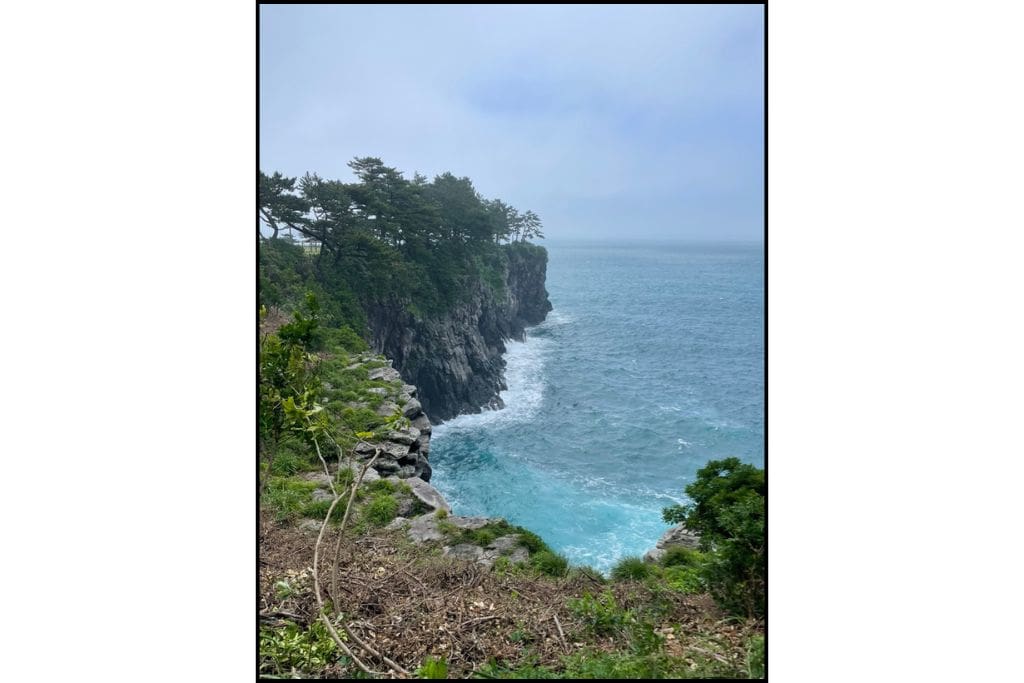
Each way comes with its own vibe, timing, and costs to consider.
I’ll break down exactly what you need to know to pick the best way to reach Jeju with zero stress.
Seoul to Jeju by Air: Fastest and Easiest Option
Flying is the fastest and most popular way to reach Jeju Island.
Most travelers heading out from Seoul fly from Gimpo Airport (GMP), which is smaller and much easier to navigate than Incheon Airport.
Flights from Gimpo to Jeju typically take around an hour, with dozens of departures daily offered by budget airlines such as T’Way, Jeju Air, Jin Air, and Air Busan.
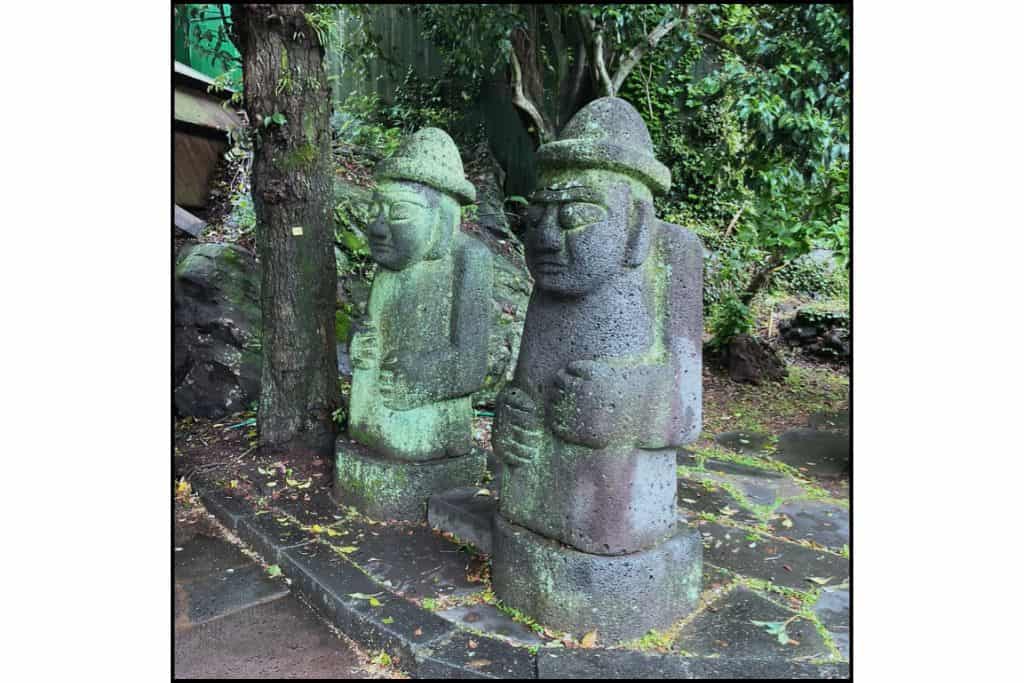
Busan to Jeju Flights: Fastest Way to Island Time
If you’re traveling from Busan, you can catch a flight to Jeju from Gimhae Airport (PUS).
Flights from Busan to Jeju are quick, usually around 50 minutes, and they’re just as affordable if you book in advance.
Whether you’re flying from Seoul or Busan, it’s smart to book early if you’re traveling during a busy season, such as cherry blossom season, summer vacation, or major holidays like Chuseok.
Flights can sell out fast, and prices tend to climb the closer you get to your departure date.
Getting to Jeju Island from Seoul: KTX Train and Ferry
The easiest way to reach Jeju Island from Seoul without flying is to take a KTX train to Mokpo, followed by a ferry ride to the island.
The train ride from Seoul Station to Mokpo Station takes about 2.5 hours.
Mokpo offers multiple ferry departures each day to Jeju, making it a convenient and popular choice.
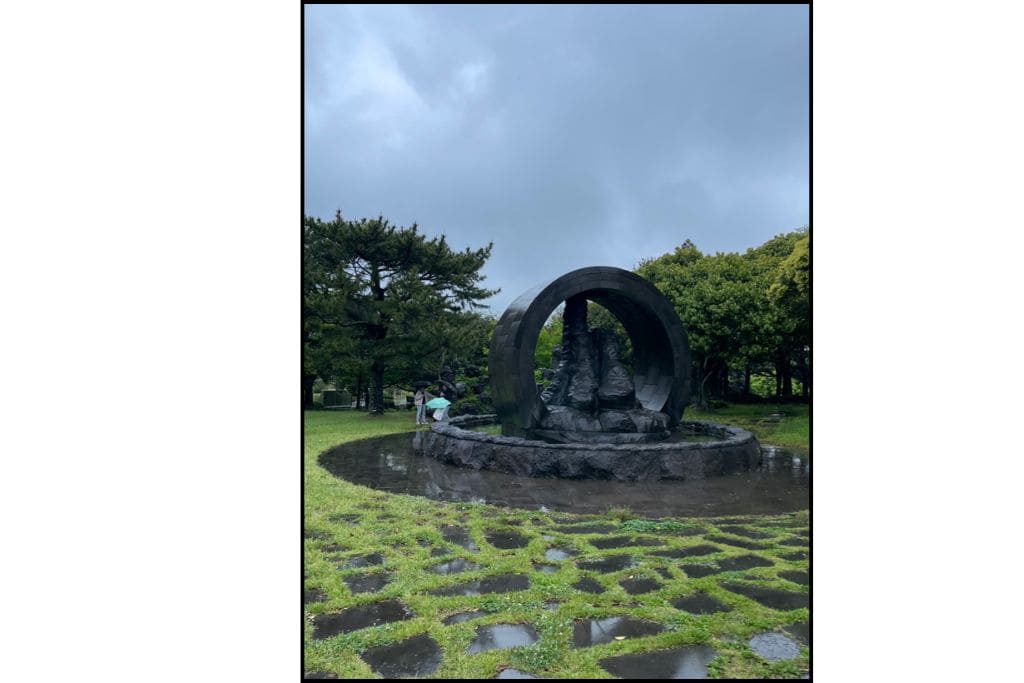
While there are also ferries from other southern ports like Wando, Yeosu, and Goheung, these are better suited for travelers who are already exploring Korea’s southern coast.
If you’re coming from Seoul, Mokpo is by far the easiest point of departure.
Travel Tip: If you’re prone to seasickness, it’s recommended to lie down during the ferry ride instead of sitting upright. It helps your body adjust to the boat’s movement and makes the journey much more comfortable.
My tour group took an overnight bus down to the Mokpo port from Seoul and caught a morning ferry.
It worked out perfectly, as we didn’t have to book a hotel for that night. When we arrived in Jeju, we loaded our luggage onto the bus and began exploring the island.
If you’re not in a rush and you enjoy the idea of watching the sea roll by, the ferry adds a little extra adventure to your trip.
Getting to Jeju Island from Busan: Ferry vs. Flight
If you’re traveling from Busan to Jeju Island without flying, it’s a bit more complicated.
There’s no direct ferry from Busan to Jeju anymore. The best course of action is to take a four-hour bus ride to Mokpo, then catch a ferry from there to Jeju.
However, between the long bus ride and ferry schedules, this route can easily take up an entire day.
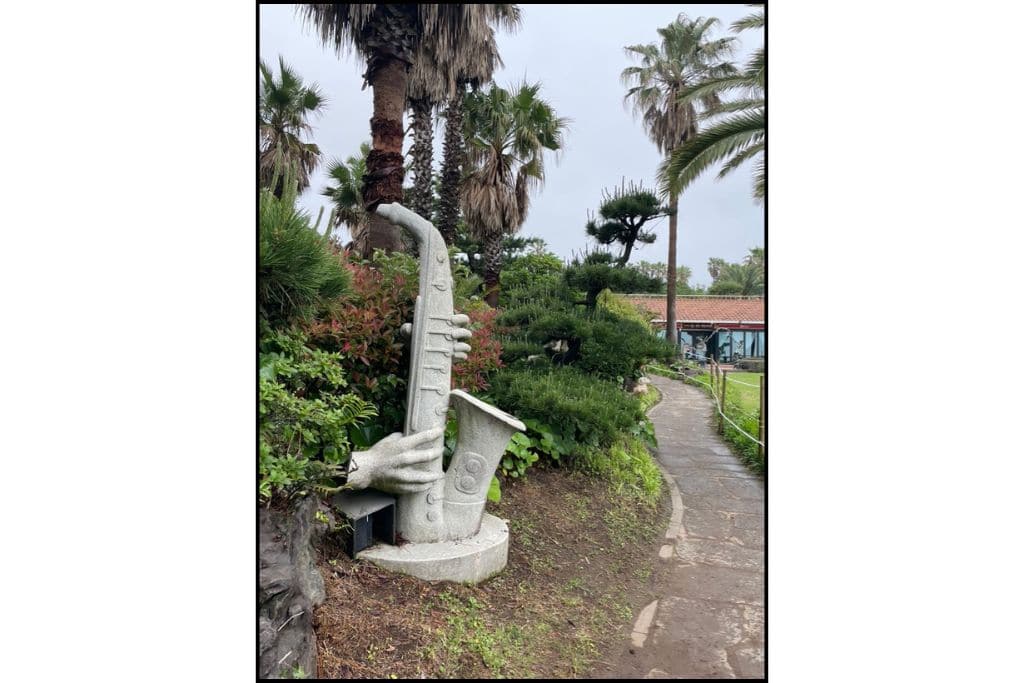
Unless you’re set on taking a ferry, I highly recommend flying from Gimhae International Airport in Busan instead.
Flights to Jeju take about one hour and are often inexpensive, saving you time and hassle.
✈️ Travel Tip:
Jeju Island has a special visa-free entry policy for travelers from select countries who fly directly to Jeju from abroad.
If you’re already in South Korea, you don’t need to worry. You can fly to Jeju from Seoul, Busan, or any other domestic city without needing a new visa.
Where to Stay on Jeju Island: City Vibes vs. Nature Escapes
When deciding where to stay on Jeju Island, most travelers choose between two main areas: Jeju City in the North and Seogwipo in the South.
Each has its own vibe, depending on the kind of trip you’re planning.
Jeju City: Convenient and Budget-Friendly
Jeju City is located near Jeju International Airport and the port, making it a super convenient option if you’re flying in late or staying for just a short time.
You’ll find tons of restaurants, cafes, shopping centers, and nightlife packed into the city streets.
It’s also the island’s main transportation hub, with bus terminals and tours frequently departing from the area.
Accommodations here tend to be more budget-friendly, offering a wide range of choices to suit all budgets.
However, because it’s more urban, Jeju City doesn’t have quite the same natural beauty that the southern coast is famous for, and you’ll need to travel farther to reach many of Jeju’s iconic attractions.
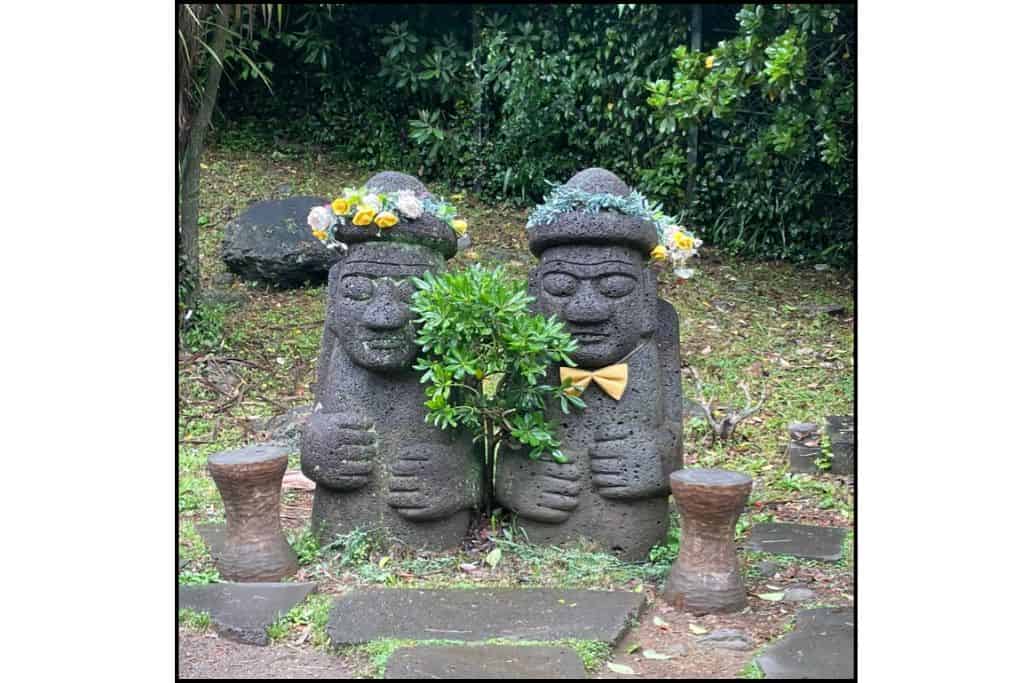
If you’re looking for walkability, city comforts, and easy airport or ferry port access, here are a few Jeju City hotels worth checking out.
📍Hotel RegentMarine The Blue (Jeju City)
Located right by the waterfront in Jeju City, this hotel offers stunning ocean views and is just a short 10–15 minute bus ride from Jeju Port. It’s also conveniently close to Tapdong Beach Plaza and Dongmun Market, making it ideal for travelers relying on public transportation. The hotel features comfortable rooms, an outdoor swimming pool, and a restaurant serving local cuisine. With its prime location and amenities, it’s a great pick for those wanting to stay near the port without sacrificing convenience.
👉 Check availability and prices at Hotel RegentMarine The Blue HERE
📍Hotel Leo (Jeju City)
This boutique hotel combines comfort with a creative flair with over 220 art pieces are displayed throughout the property. It’s located just 10 minutes from Jeju Airport by car or bus, and within walking distance to bus stops, shops, and restaurants. Rooms are modern and well-equipped, and the hotel includes a buffet restaurant and bar. A great pick for travelers without a car who still want a stylish stay.
👉 Check availability and prices at Hotel Leo HERE
📍Lotte City Hotel Jeju
A modern, well-located hotel in Jeju City, just a quick 10-minute bus or taxi ride from both the airport and the Intercity Bus Terminal. It’s a smart pick for travelers getting around by public transportation. The hotel offers spacious rooms, a rooftop pool with ocean views, a fitness center, and an on-site buffet restaurant. You’ll also find convenience stores, cafés, and frequent bus stops within walking distance, making it easy to explore without a car.
👉 Check availability and prices at Lotte City Hotel Jeju HERE
Seogwipo: Scenic Stays Along the Southern Coast
Prefer ocean views, waterfalls, and a slower pace? Seogwipo is all about laid-back coastal beauty and easy access to Jeju’s natural wonders.
Located on the southern coast of the island, Seogwipo offers a more relaxed, nature-focused vibe compared to Jeju City’s urban energy.
You’ll find famous spots like Cheonjiyeon Waterfall, Jeongbang Waterfall, and the dramatic Jusangjeolli Cliffs just a short drive away.
Seogwipo also has traditional markets and local restaurants where you can dive into Jeju’s unique food culture.
It’s about a one-hour drive from Jeju International Airport, so it’s a little less convenient for quick trips.
Although buses are available, renting a car will give you much more freedom to explore the southern coast at your own pace.
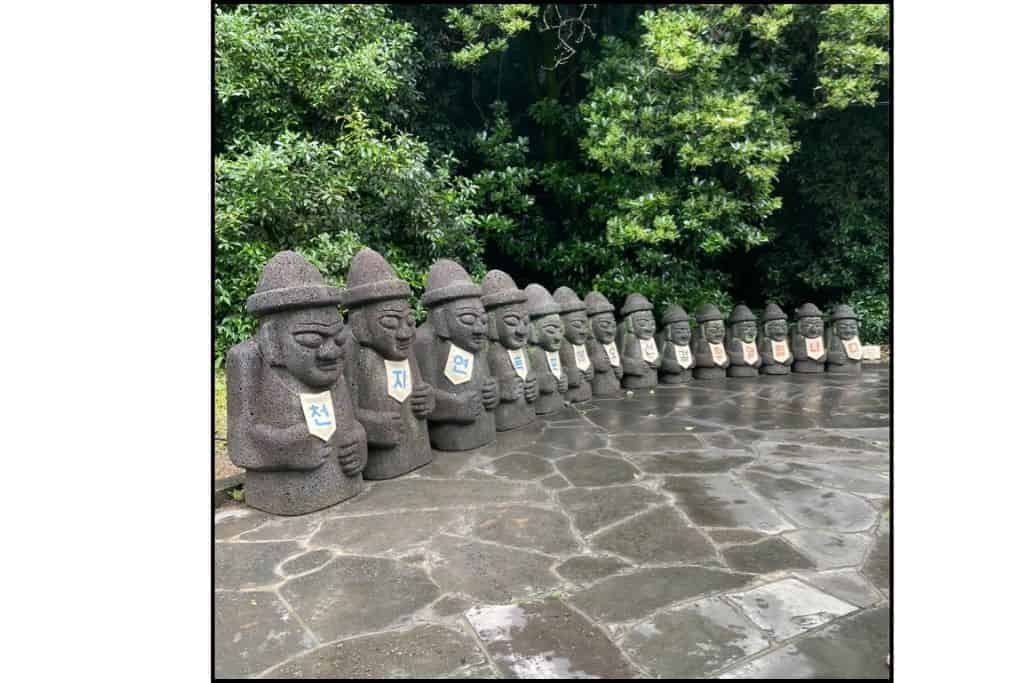
If you’re staying in Seogwipo, these hotels put you right near the waterfalls, markets, and coastal trails without straying too far from comfort or convenience.
📍 Shin Hotel Jeju Ocean – Big Rooms, Bigger Views
Spacious rooms with kitchenettes and washing machines make this hotel a smart pick for longer stays or travelers who like extra room to breathe. Located near Cheonjiyeon Falls and the coastal walking path, it’s a convenient and comfortable base in Seogwipo.
👉 Book Shin Shin Hotel Jeju Ocean here
📍Cheonjiyeon Crystal Hotel – A Solid Base in Seogwipo
A clean, modern mid-range hotel in Seogwipo is ideal if you want to stay close to Jeju’s southern coastline without breaking your budget. It’s near the harbor, with cafés, shops, and convenience stores just a short walk away. A practical pick for exploring southern Jeju at your own pace.
👉 Check prices and availability HERE
📍Casaloma Hotel – Rooftop Views & Spacious Comfort
Modern rooms, a seasonal rooftop pool, and views of Seogwipo’s coastline make Casaloma Hotel a relaxing spot to wind down after a full day of sightseeing. It’s close to Olle Market and several major attractions, so you won’t have to wander far for good food or a scenic stroll.
Getting to Your Hotel from the Airport
If you’re staying in Jungmun or Seogwipo, the Airport Limousine Buses (600, 800, 800-1) are the easiest way to get there directly from Jeju Airport, no car or transfers needed.
🧳 These buses are big, comfy, and luggage-friendly is ideal if you’re arriving with a suitcase and zero interest in figuring out local transfers after a flight.
City Vibes + Nature Views: Stay in Both!
If your itinerary allows, consider splitting your stay between Jeju City and Seogwipo.
Spend a few nights in Jeju City for easy access when you arrive, then move down to Seogwipo to dive into the natural side of the island.
This setup gives you easy access to both the major east coast spots and the southern natural wonders.
Exploring Jeju Without a Car: Public Transit Tips & Tricks
Jeju’s public transportation can get you to most major sights, but it’s not always the fastest or most convenient. If you’re not renting a car, here’s a quick look at your best options:
The Regular Bus System
Jeju’s local buses are color-coded to help you figure out where they go:
- 🔴 Red (Express): Fewer stops, faster service to major destinations
- 🔵 Blue (Trunk): Connects towns and cities across the island
- 🟢 Green (Local): Covers smaller neighborhoods and rural areas
Travel Tip: Use KakaoMap or Naver Map for route planning, and Jeju Bus – Jejudo Busro app to check arrival times and how many seats are available in real time.
Jeju Tourist Shuttle Buses
If you want to hit Jeju’s top sights without figuring out transfers, these loop-style shuttle buses are a smart pick/ Please note you will need to take another bus to get to these routes.
- 🚍 Bus 810 (East Route): Seongsan Ilchulbong · Seopjikoji · Bijarim Forest
- 🚍 Bus 820 (West Route): Hallim Park · Hyeopjae Beach · O’sulloc Tea Museum
These buses include onboard guides and let you hop on and off at major tourist stops.
For full route details and schedules, check the official Jeju Tourist Shuttle Bus page. The ₩3,000 day pass can be purchased in person at the Daecheon Transit Center (810) or Donggwang Transit Center (820).
Jeju City Tour Bus
Spending the day in Jeju City? This hop-on-hop-off bus hits 21 locations, including:
🛍️ Dongmun Market · 🪨 Yongduam Rock · 🏛️ Jeju Folklore & Natural History Museum
It’s an easy way to sightsee without worrying about transfers.
📍 Check stops and schedules at jejucitybus.com
Seogwipo Electric City Tour Bus (Bus 880)
If you’re staying in Seogwipo and skipping the rental car, this quiet electric bus is a hidden gem. It loops through key southern sights like Cheonjiyeon Falls and Oedolgae Rock, no need to navigate or drive.
Click HERE for the more information about the route and schedule details.
Tips for Using Public Transportation in Jeju
To make the most of Jeju’s public transit system, you’ll want to have a few essential apps ready to go.
KakaoMap or Naver Map will help you plan routes and transfers, while Jeju Bus – Jejudo Busro app gives real-time updates, including how many stops away your bus is and whether there are seats available. You can also use KaKaoBus app.
Skip Google Maps as it just doesn’t work well in Korea.
Even with apps, it’s a good idea to check the actual timetables posted at the bus stop, especially in more rural areas.
Be prepared for some walking, too. The buses don’t always stop directly in front of attractions.
The buses generally run on time. However some routes, like the rural routes on the green buses don’t come very often. If you miss one, you might be waiting a bit, so plan accordingly.
If you’re short on time or want to reach remote spots like waterfalls or volcanic craters, booking a guided tour might save you a lot of effort and stress.
Want more detailed info on how to use the bus system? I wrote a full guide just for that with tips on routes, apps, and getting around smoothly. 👉 Getting Around Jeju Without a Car: A Bus Travel Guide for Tourists
My Guided Jeju Island Adventure
Since getting around Jeju without a car can be tricky, I decided to join a guided tour that hit some of the island’s biggest highlights.
Honestly, the idea of driving in South Korea didn’t excite me. And for a first trip to a new place, I love being able to just relax, meet some fun people, and let someone else handle all the logistics.
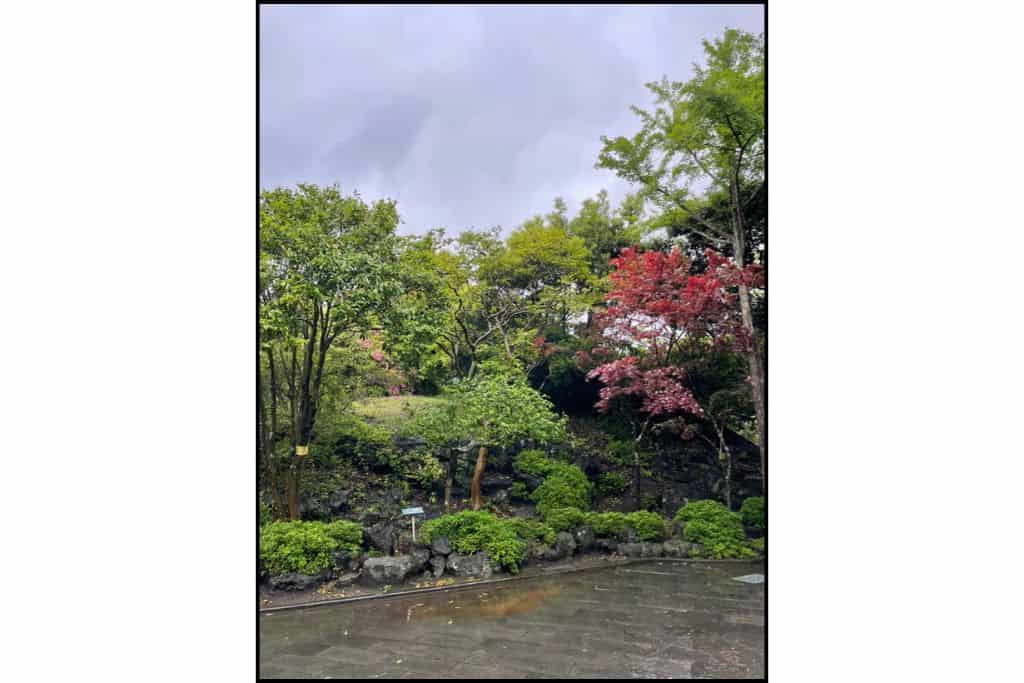
As a solo traveler, it’s also nice to have built-in dining companions along the way.
You simply hop on the bus, kick back, and enjoy the ride or nap until the next stop with enough free time at each site to really explore without feeling rushed.
Here’s a look at where we went and what stood out along the way.
Manjanggul Lava Tube
One of our first stops was the Manjanggul Lava Tube, an enormous underground tunnel formed by ancient volcanic activity.
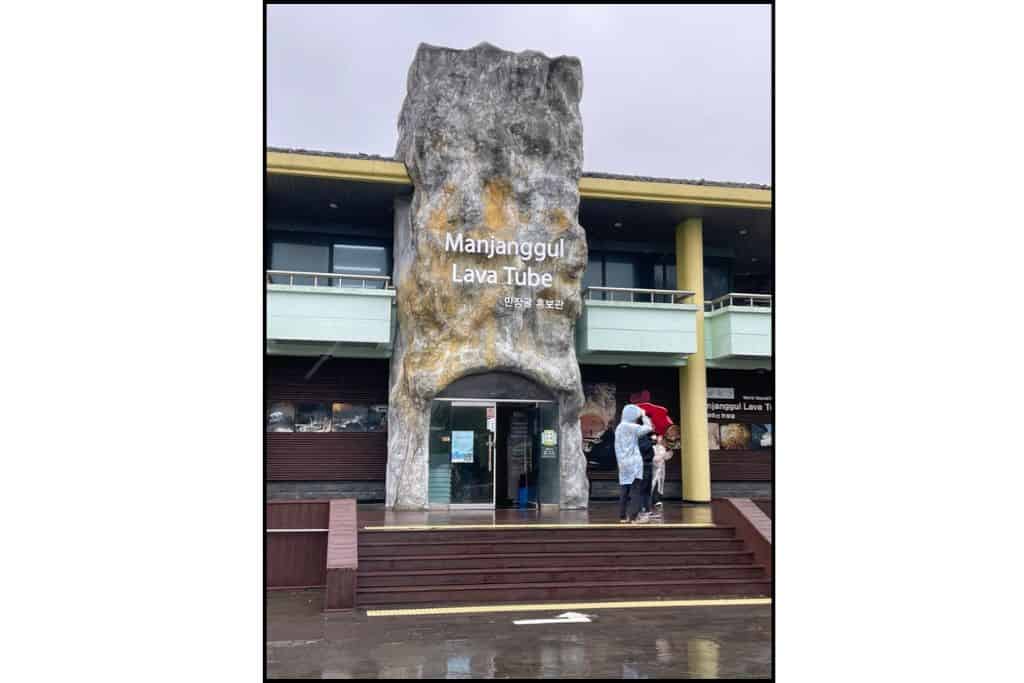
Walking through it felt like stepping into another world, cool, dimly lit, and filled with strange rock formations that looked almost alien.
The section open to the public is about one kilometer long, and the path is mostly flat, but it’s very slippery in spots.
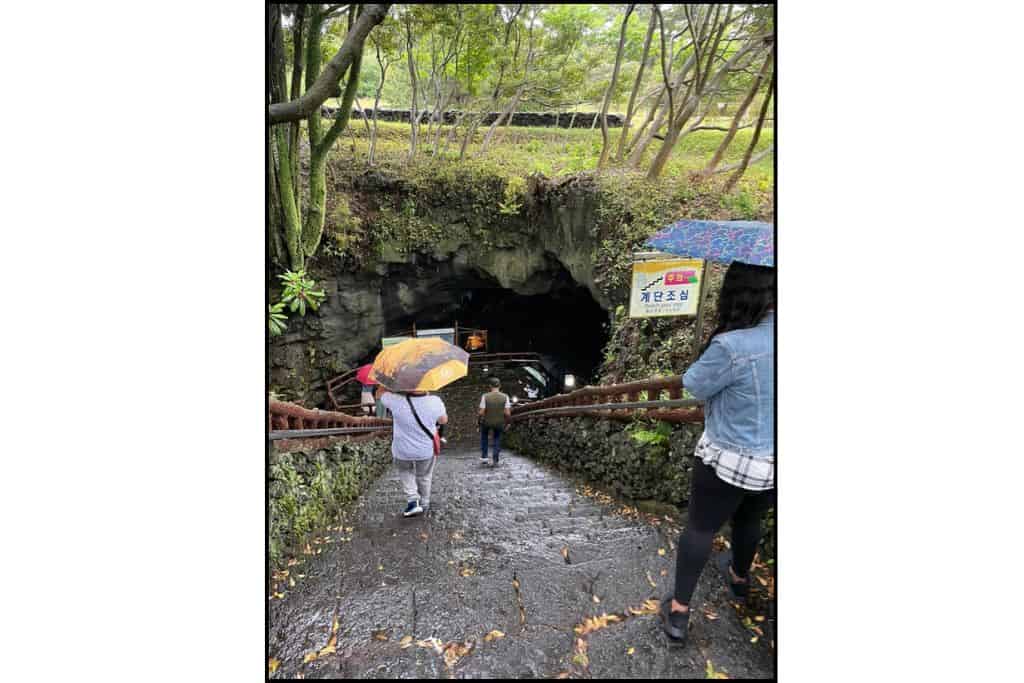
The wet, slippery rock surface can catch you off guard if you rush, so I strongly advise taking your time and wearing sturdy shoes.
Even with careful footing, the surreal atmosphere inside made every step feel like part of an adventure.
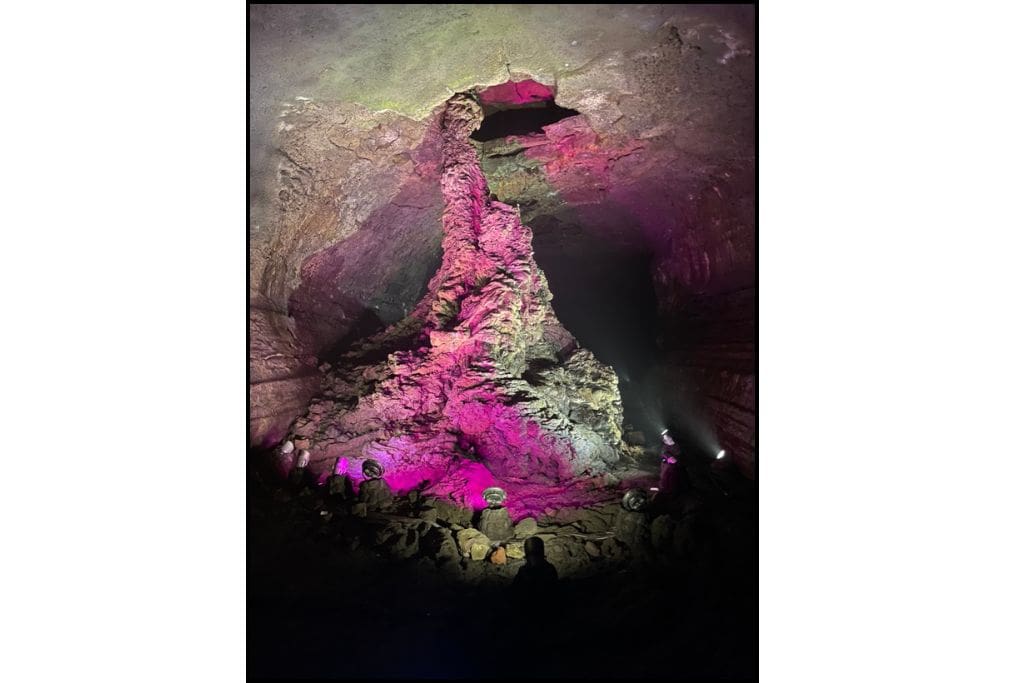
After exploring the cave, we found a small café and gift shop near the entrance, perfect for a quick break.
They had the cutest souvenirs with a Jeju tangerine theme, from snacks to fun accessories, so make sure to bring your wallet.
I ended up buying an adorable canvas bag covered in tangerines, and I seriously had to stop myself from grabbing one of the hats shaped like a giant tangerine.
It’s one of those places where you’ll want to bring home a little piece of Jeju’s charm.
Heads up: Manjanggul Lava Tube is temporarily closed for maintenance and is expected to reopen in August 2026.
Seongsan Ilchulbong (Sunrise Peak)
After visiting the cave, we made our way to Seongsan Ilchulbong, also known as Sunrise Peak, around mid-afternoon.
Normally, this dramatic volcanic crater offers stunning ocean views and is one of the best places on Jeju Island to watch the sunrise.
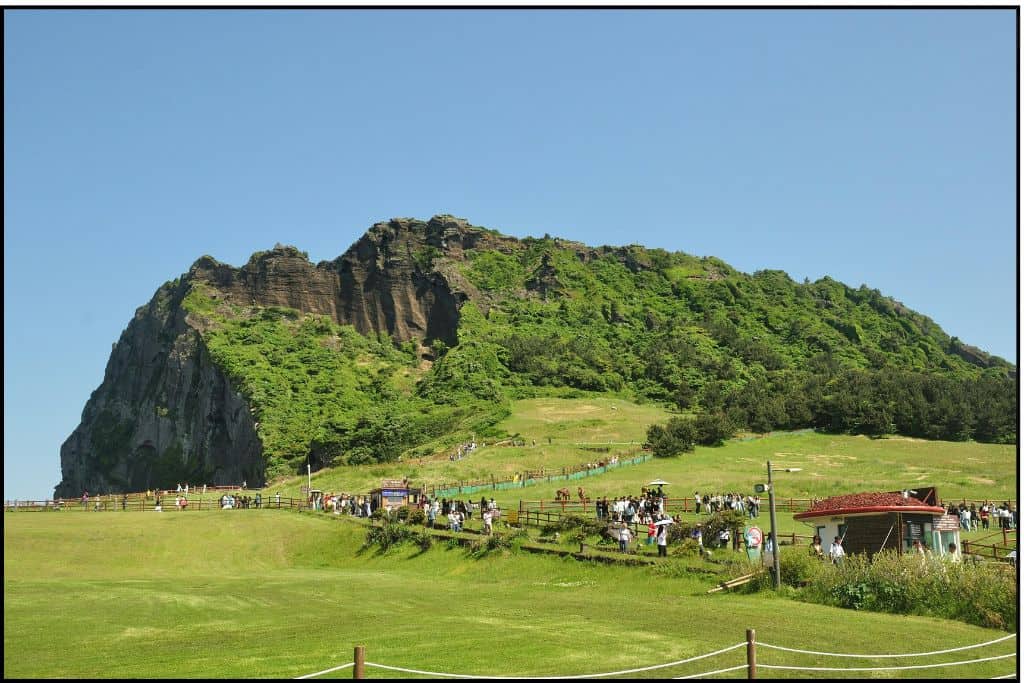
Unfortunately, the weather had other plans. Rain and thick fog rolled in, and the peak was closed for safety.
Since it was chilly and a little disappointing not to hike to the top, a new friend I met on the tour and I decided to warm up with a little shopping in the nearby village area.
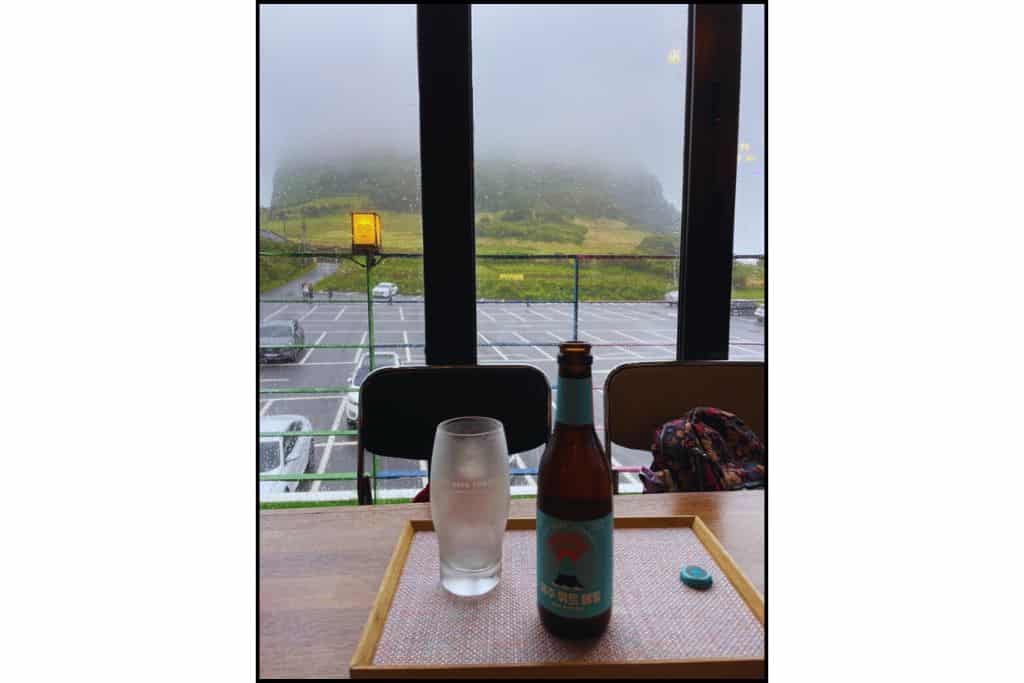
That’s where I found some of my favorite Jeju souvenirs, including the themed lip balms I’m now a little obsessed with.
We also ducked into a cozy café, where I tried a local Jeju beer while we waited out the rain.
Jeju Black Pork Dinner
We wrapped up the day with a classic Jeju Black Pork barbecue dinner, and honestly, it lived up to all the hype.
The pork was incredibly tender and smoky, grilled right at our table.
If you’ve never tried black pork before, it’s a local Jeju specialty, prized for its rich flavor and perfect marbling.
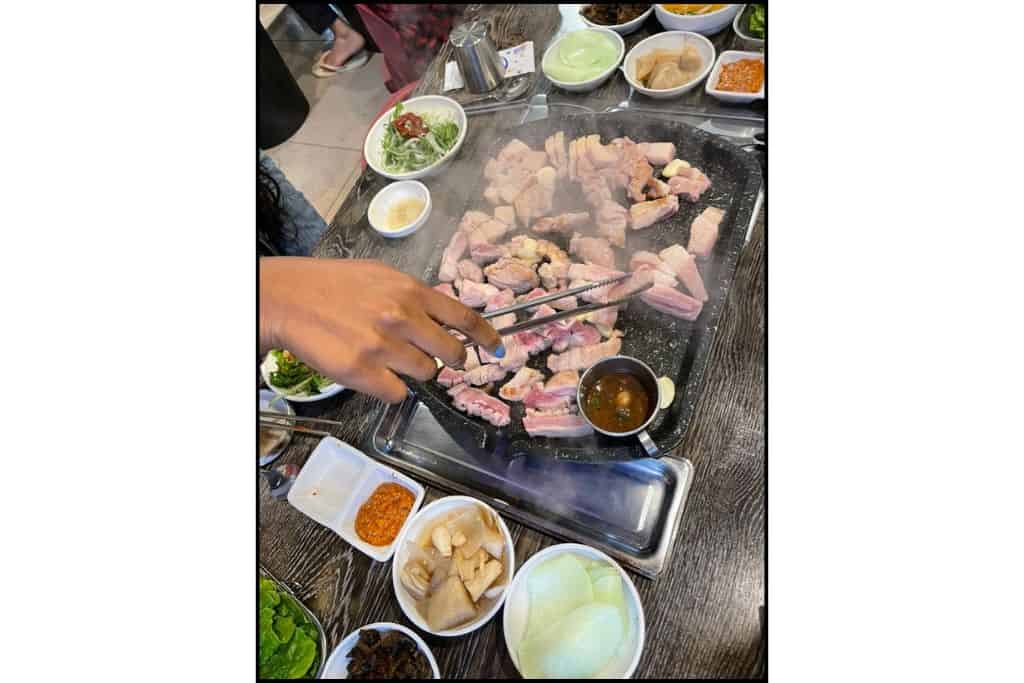
Sitting around the grill with a table full of new tour friends, swapping stories, and clinking tiny soju glasses just felt like the perfect way to end a rainy day.
Fueled up from dinner and a solid night’s rest, I was ready to dive into Day 2 and the next round of epic Jeju sights.
Jusangjeolli Cliffs
The next morning, we hit the road early and headed for Jeju’s southern coast.
Our first planned stop was the Jusangjeolli Cliffs, a rugged stretch of coastline famous for its dramatic volcanic rock formations.
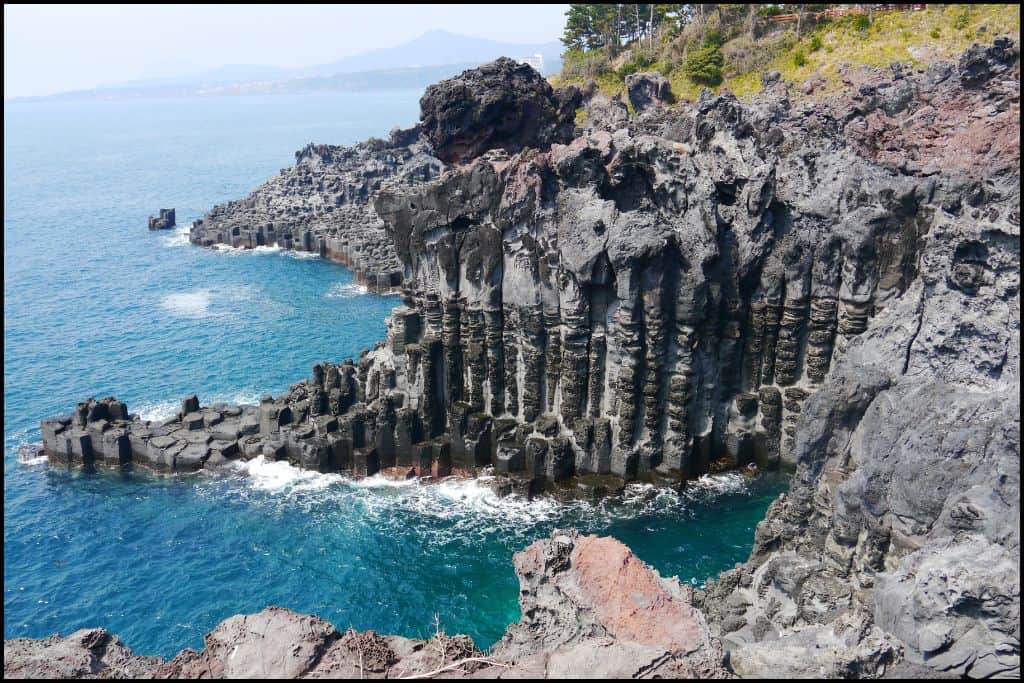
The cliffs look like massive stone pillars stacked side by side like something pulled straight from a fantasy novel.
Unfortunately, due to the wind and rain, the site was closed for safety reasons.
We couldn’t climb the stairs or get a close-up look at the cliffs and ocean like we’d hoped.
Cheonjeyeon Waterfalls
Since the cliffs were closed, we headed to the Cheonjeyeon Waterfalls, located in the lush Jungmun area of Jeju.
Most of our time was spent at the lower falls, surrounded by winding pathways and lush greenery that felt like stepping into a hidden garden.

There’s a large rock near the water that’s perfect for photos. Just be prepared to wait a bit if you want your turn.
Beyond that, the whole area is packed with scenic bridges, peaceful walking paths, and vibrant gardens that feel like something out of a dream. It’s a photo lover’s paradise.
You’ll even spot plenty of Jeju’s famous Dolhareubang statues scattered around the gardens .
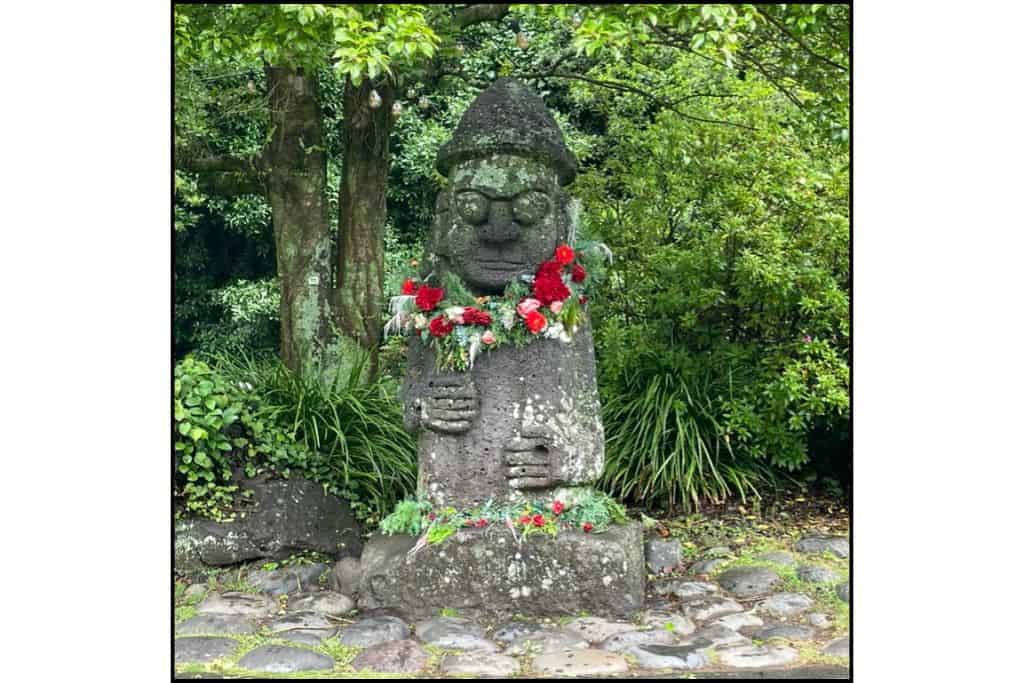
The cheerful “stone grandpas” that have become a symbol of the island.
It’s a leisurely, peaceful stroll to the falls, lined with small stands and souvenir shops, so remember to bring your wallet!
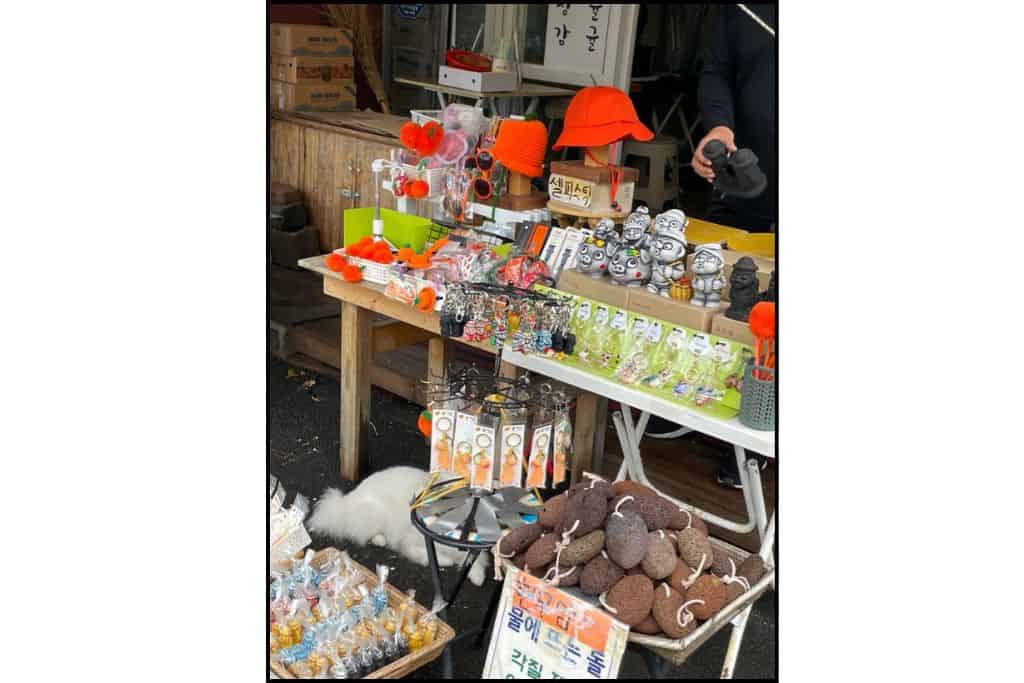
I picked up a volcanic rock bracelet at a shop here, but you’ll also find snacks, local crafts, and plenty of little Jeju-themed goodies to tempt you.
Oedolgae Sea Stack
Our next stop was the Oedolgae Sea Stack in Seogwipo, a towering rock formation that juts dramatically out of the ocean.
The setting here feels almost cinematic. The endless stretch of water, the rugged cliffs, and the lone stone pillar standing against the waves.
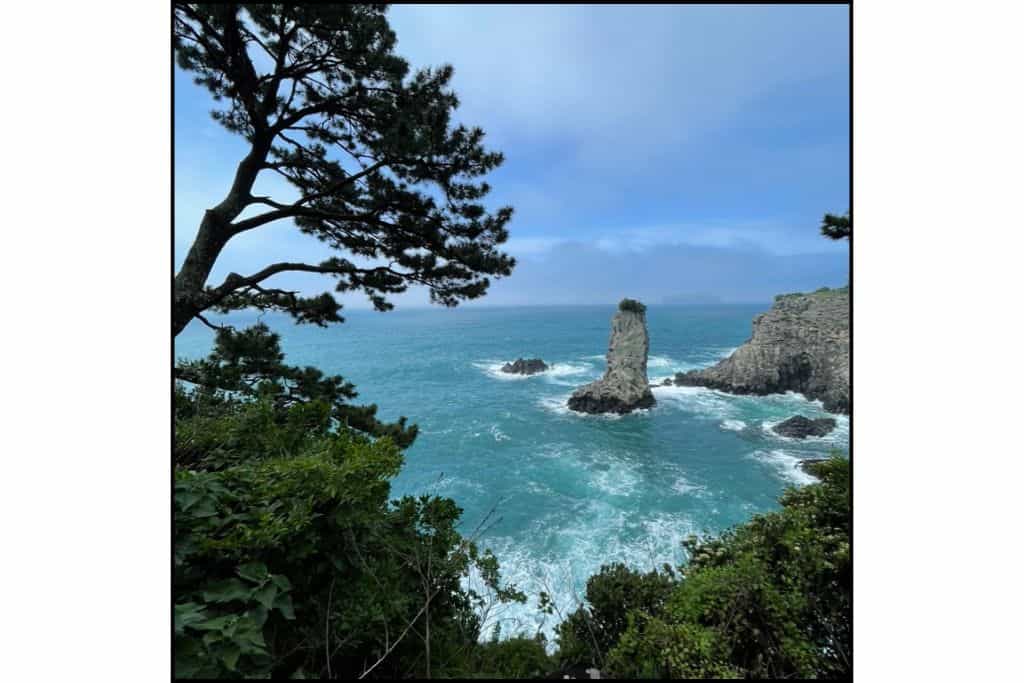
We took a relaxed stroll along the coastal walk, where different viewpoints offered beautiful angles of the sea stack and the coastline beyond.
It wasn’t a rushed visit, just an easy, peaceful break to breathe in the salty air, snap a few photos, and enjoy the scenery before heading back to the bus.
Udo Island
After a busy morning of sightseeing, we headed to the ferry terminal for the next part of the adventure: Udo Island.
We caught the ferry and arrived ready to explore a whole new side of Jeju. Remember, you can lie down to avoid seasickness.
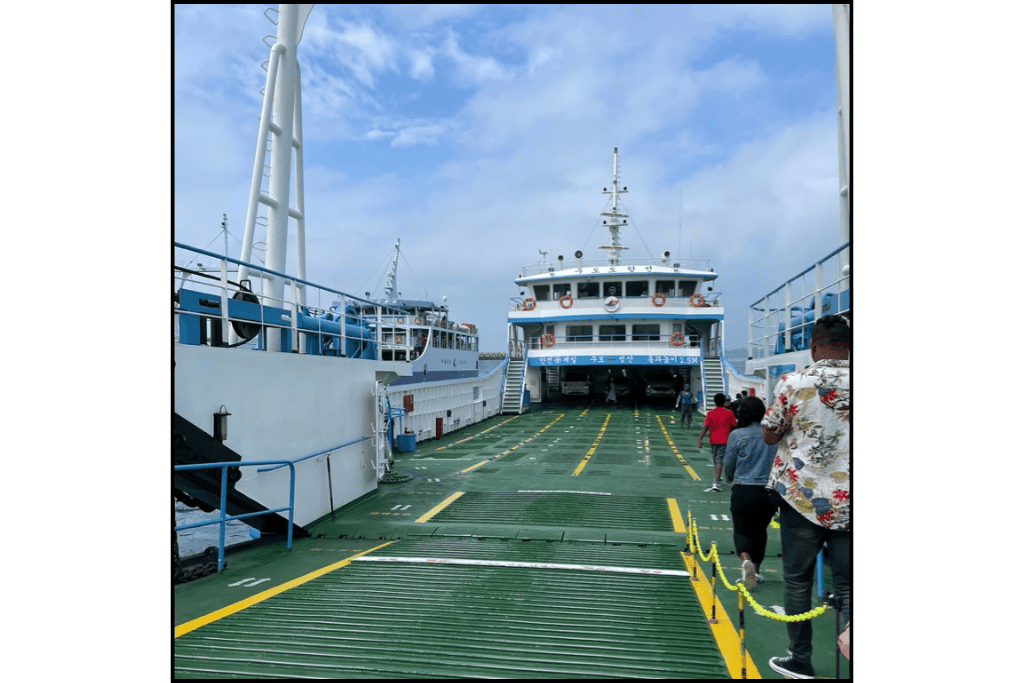
Udo has a completely different vibe, more relaxed and rural, with wide-open beaches, farm fields, and seaside cafés dotting the coastline.
Fun fact: The island’s name actually means “Cow Island,” and if you look at it on a map, it’s roughly shaped like a cow lying down.
Everything moves a little slower here, and it’s the perfect place to catch your breath and soak up the scenery.
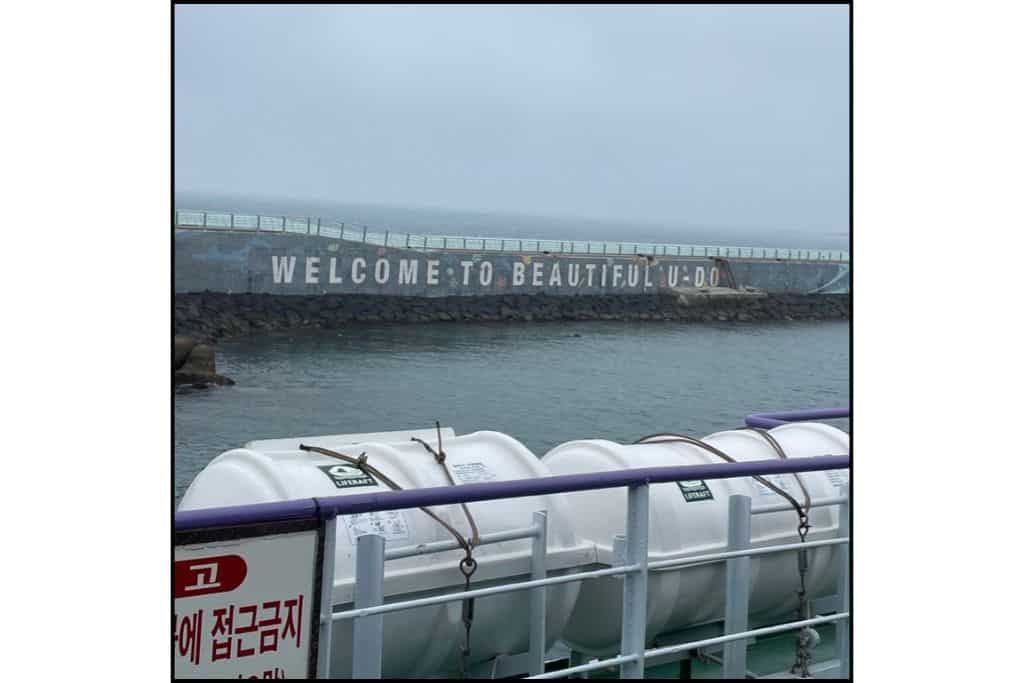
Since Udo is famous for its peanuts, trying the local specialties was a must.
I grabbed a peanut beer and peanut makgeolli. While it sounds odd, it was surprisingly good and super refreshing after all the walking.

Don’t sleep on the peanut ice cream either. It’s sweet, nutty, and absolutely worth making room for, as well as refreshing after a lot of walking!
I also visited Rhodolith Beach, a rocky shoreline famous for its pink-toned coralline algae.
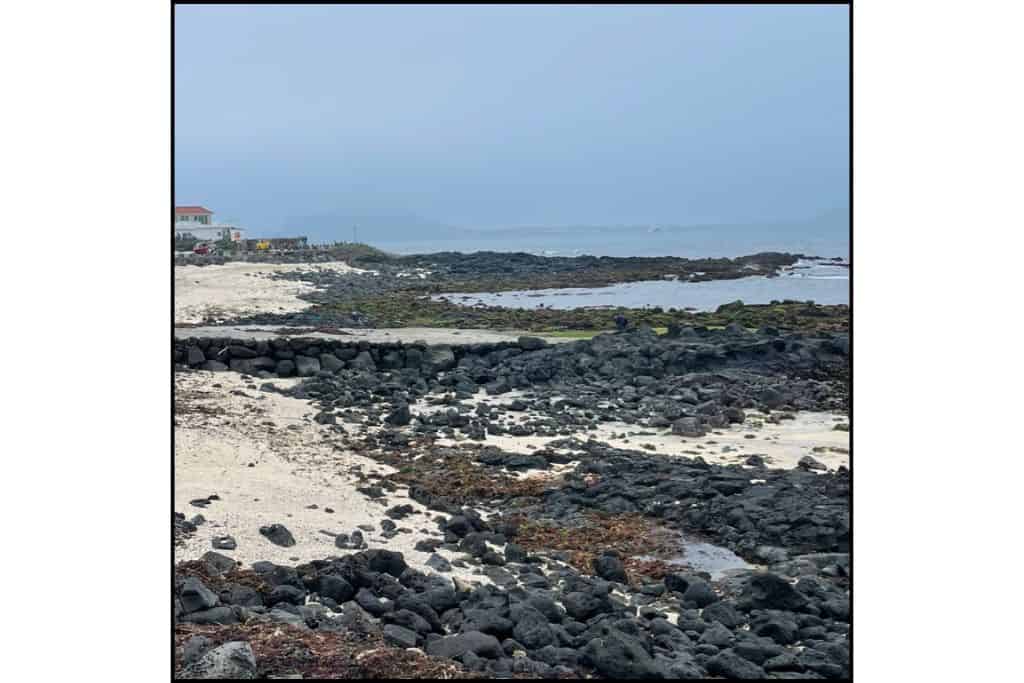
It’s not your typical sandy beach, but the pink hues against the turquoise water made for some incredible photos.
Make sure your phone is charged for the photos you’ll want to take.
Wrapping Up Our Jeju Adventure
After soaking up Udo’s laid-back atmosphere, we caught the ferry back to Jeju and made our way into the city as evening fell.
We wrapped up the trip with a delicious dinner at Halla Arboretum Theme Park. It’s not a ride-in-sight kind of theme park.
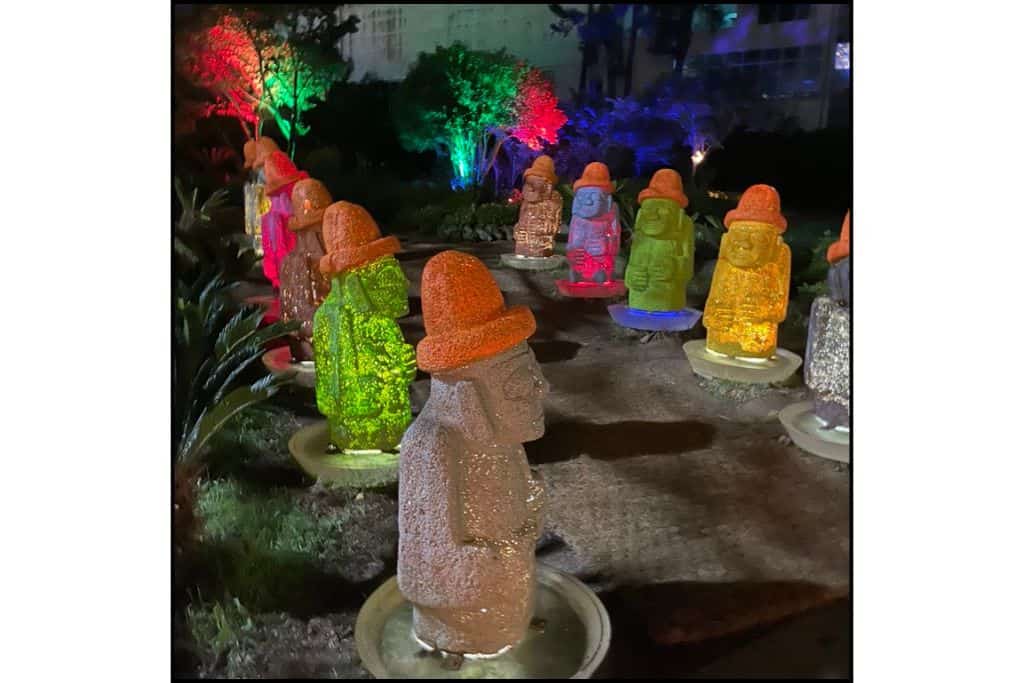
It’s more of a scenic dining area with glowing Dolhareubang statues, cozy outdoor seating, a small night market on one side, and even a 4D theater tucked among several restaurants.
It was the perfect place to wind down after a day of exploring, a hidden gem that captures Jeju’s easygoing charm.
Heading Back to Seoul
The last morning of the trip was mostly about getting back to the mainland.
We caught the early ferry, then settled in for a long bus ride back to Seoul.
It wasn’t the most exciting part of the adventure, but after two full days of sightseeing, it was actually nice to just sit back, relax, and watch the Korean countryside roll by.
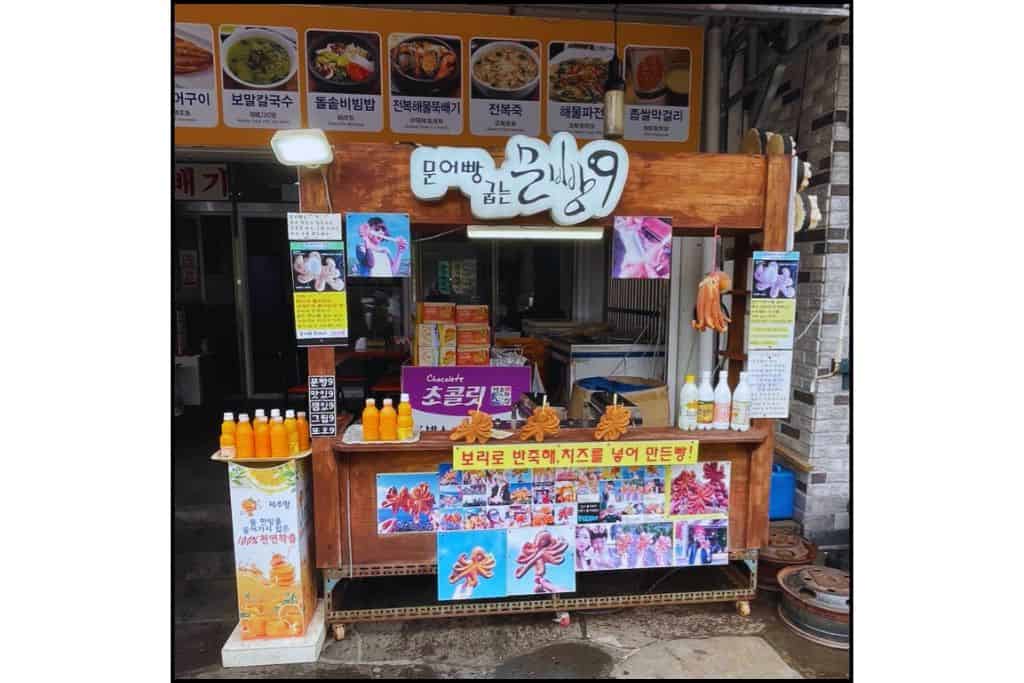
Even though the tour packed in a lot, there’s still so much more I want to experience on Jeju Island.
If , or let’s be honest, when, I go back, here’s what’s on my Jeju wish list.
Still on My Radar: Hidden Gems & Big Views
Even though the guided tour covered a lot, I left Jeju feeling like I had only scratched the surface.
There’s still so much more of the island I want to explore, from hidden gems to epic coastal scenery and quirky must-sees tucked off the main routes.
Next time, I’m planning to mix things up: a few guided tours for the big highlights, plus a day or two of renting a car to chase down the spots that tours don’t always reach.
Here’s what’s still topping my Jeju Island bucket list and a few places you might want to add to yours too.
West Jeju – Aewol and Hyeopjae Beach Area
Jeju’s west coast is high on my list for next time, especially the Aewol and Hyeopjae Beach areas.
Hyeopjae Beach is famous for its soft white sand and clear turquoise water. It’s perfect for a slow afternoon by the sea.
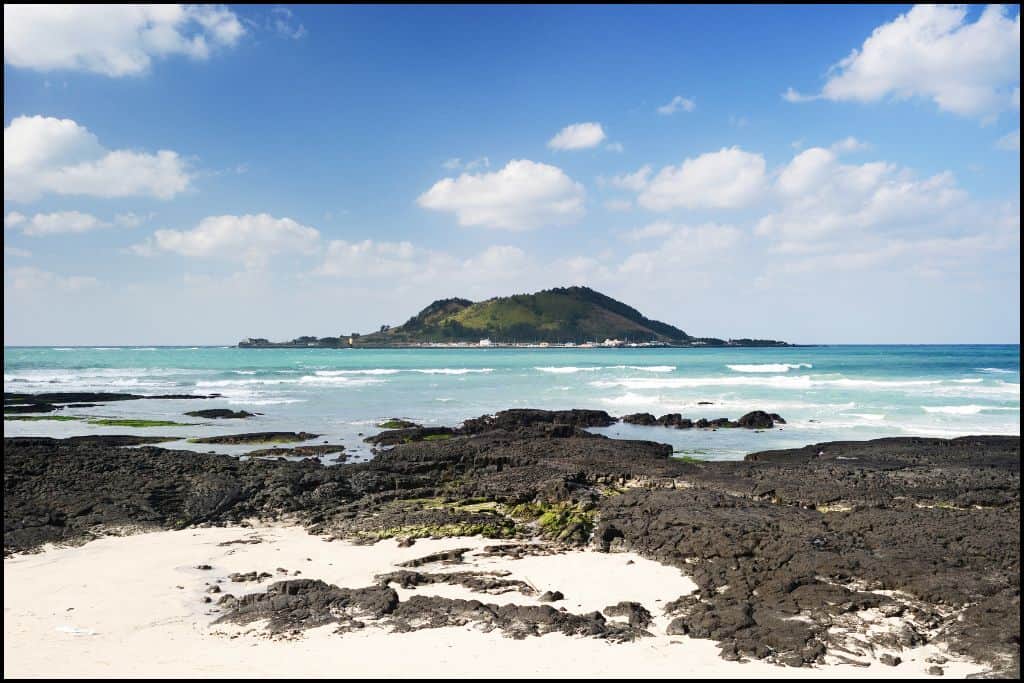
While I’m out that way, I’d love to stop by the Osulloc Tea Museum (because who can say no to green tea everything?) and maybe even pop into Hello Kitty Island, purely for the fun photos, of course.
Aewol Cafe Street is another must-visit: a scenic coastal road lined with oceanfront cafes, boutique shops, and cozy patios.
It looks like the perfect place to grab a coffee, snap some photos, find a few unique souvenirs, and soak up the relaxed seaside vibe that Jeju is famous for.
South Jeju – Seogwipo Area
Seogwipo has so much to offer, and I’d love to spend more time exploring the south side of Jeju.
First on the list: visiting the Citrus Museum, Jeju’s famous tangerines deserve a little extra love!
I’d also like a second chance to see Cheonjeyeon Waterfalls and the Jusangjeolli Cliffs. Hopefully with better weather this time around.
Both spots were beautiful even in the rain, but I can only imagine how stunning they are on a clear day.
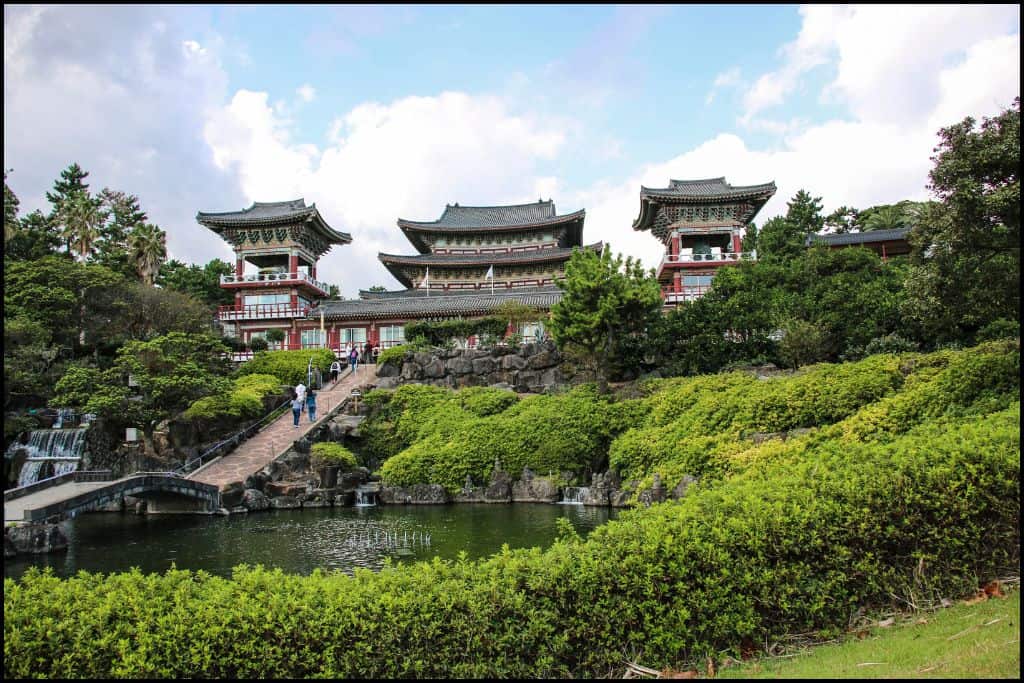
Another place that caught my eye is Yakcheonsa Temple, one of the largest temples in Korea. It looks absolutely breathtaking in photos, and I’d love to experience it in person.
I need to visit Sanbangsan Mountain Hot Springs next time. It’s a carbonated hot spring in Seogwipo with outdoor baths and mountain views.
I’m absolutely booking Sanbangsan Mountain Hot Springs on my next trip — outdoor carbonated spa with a view? Yes, please. Get a discounted ticket HERE
📍Want to explore Jeju’s west and south without the planning stress?
This all-in-one tour hits Hallim Park, Hyeopjae Beach, Cheonjeyeon Waterfall, O’sulloc Tea Fields, and more with a licensed guide and lunch included. Book your full-day adventure here and see the best of Jeju in one go.
Udo Island Adventures
During my last visit, the weather wasn’t ideal for fully exploring Udo Island, so it’s definitely on my list to revisit.
I’d love to check out Seobinbaeksa Beach, famous for its brilliant white coral sand, and spend more time wandering the cafes and quiet beaches Udo is known for.
Of course, I’ll be grabbing more peanut ice cream and maybe another peanut beer for good measure.
East Jeju – Bonus Spots I Want to Visit
The eastern side of Jeju has a few places that are definitely calling my name.
Snoopy Garden looks absolutely adorable. Whimsical paths, fun photo ops, and the perfect setting for a laid-back afternoon stroll. Click HERE for discounted tickets!
Hamdeok Beach is famous for its soft white sand and shallow turquoise water, making it a beautiful place to kick back and relax for a few hours.
I’d also love to visit the Haenyeo Museum to learn more about Jeju’s legendary women divers and their incredible tradition.
These women are real-life superheroes. Their stories are a huge part of Jeju’s cultural identity. There’s even a lip balm shaped like them!
📍Want to see Jeju’s east side without the hassle?
This full-day tour covers Seongsan Ilchulbong, a traditional folk village, a live Haenyeo show, and more, all with a guide, lunch, and zero planning stress. Book it here and see why the east coast is a must.
Jeju Island FAQ
Most travelers who can visit South Korea visa-free can also travel to Jeju Island without a separate visa. If you’re already in Korea, flying to Jeju is considered a domestic flight and no additional visa is needed.
Most travelers spend 2 to 4 days on Jeju Island. If you want to hit major sights without rushing, 3 days is ideal. If you want to dive deeper and explore hidden beaches and villages, consider staying 5 days or longer.
Renting a car definitely makes getting around Jeju easier, but it’s not the only option.
The bus system covers major areas, though it can be slow and less convenient for reaching more remote spots. If you don’t want to drive, joining a guided tour is a great way to see the island without worrying about transportation.
Pro Tip: You’ll need an International Driving Permit (IDP) if you plan to rent a car in Korea.
Jeju is known for its volcanic landscapes, white sand beaches, tangerines, lava tubes, haenyeo (female free divers), scenic coastal walks, and specialty foods like black pork and peanut ice cream.
Final Thoughts on Visiting Jeju Island
Even with two packed days of sightseeing, it feels like I only scratched the surface of everything Jeju has to offer.
Whether you’re climbing volcanic craters, lounging on white sand beaches, or café-hopping through quirky neighborhoods, Jeju delivers a little bit of everything, and then some.
I’m already counting down the days until my next visit. This time, with plans to slow down, wander farther, and finally cross a few more spots off my Jeju wish list.
Until next time, Jeju! Save a few hidden gems for me.
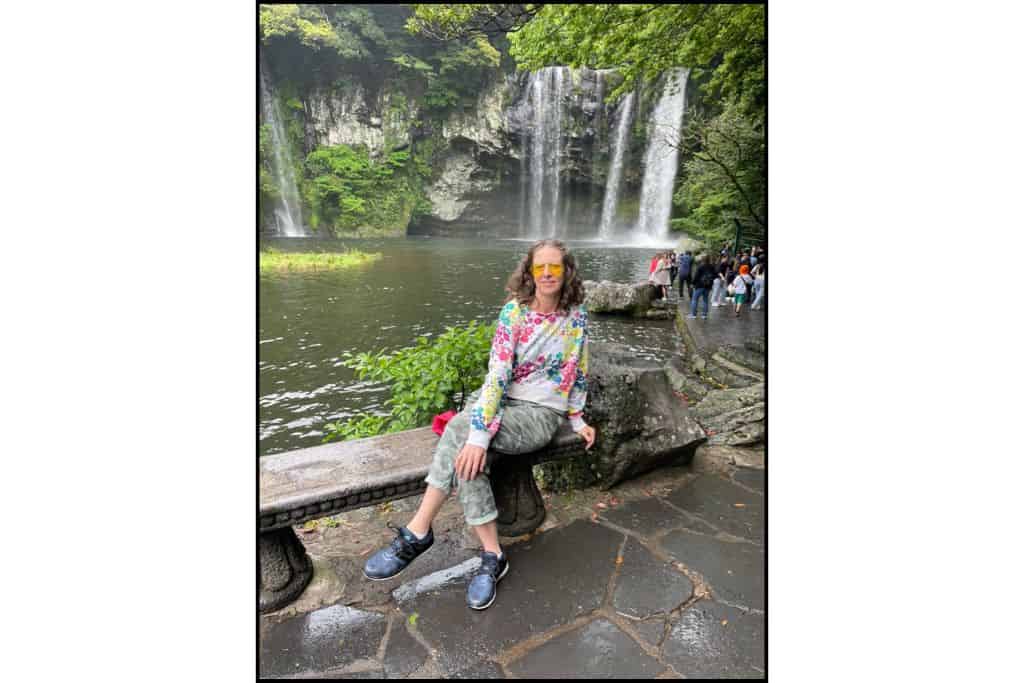
Planning a trip to South Korea?
Don’t miss my other travel guides to help you plan the ultimate adventure, from city strolls in Seoul to beach escapes in Busan.
Start with my Seoul Itinerary and Busan Itinerary to map out your journey!
And if Jeju Island is on your list (trust me, it should be), make sure to save this guide for your itinerary planning.
Need tickets? Book your KTX train tickets early for an easy connection to the ferry port.
